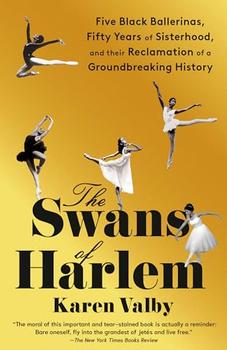Summary | Excerpt | Reviews | Beyond the book | Read-Alikes | Genres & Themes | Author Bio

Five Black Ballerinas, Fifty Years of Sisterhood, and Their Reclamation of a Groundbreaking History
by Karen ValbyJournalist Karen Valby's first book, The Swans of Harlem, introduces readers to the little-known history of the Dance Theater of Harlem, which was founded in 1969 by Arthur Mitchell. Using interviews and research from print archives, Valby deftly crafts information into a compelling narrative centered around the company's ballerinas. The fact that none of the names were familiar to me demonstrated the need for the book's existence. I really enjoy histories like this that focus intimately on a small group of people.
The Swans of Harlem opens shortly after Martin Luther King, Jr.'s assassination, a time when many people felt called to lift up Black communities. Arthur Mitchell answered that call with his decision to open a ballet school that cultivated the talents of Black dancers. He found initial interest but discovered that potential donors would often back out. Undeterred, he cobbled together what he needed—he got the Singer company to loan sewing machines and a fabric company to donate fabric, and he occasionally covered expenses out of his own pocket. Through it all, he offered his dancers endless support. When one was homesick abroad, he flew her brother out to be with her. When another revealed she had children, he gave her a raise.
At the same time, his idealism came bundled with a need for control and a short fuse when things didn't go his way. Dancers tell countless stories of his tirades and perfectionism veering into cruelty. He micromanaged everything about them, especially what they ate and what they weighed. It's clear, however, that his harsh methods were a response to racism. The Black dancers faced extra scrutiny and a lot of extra work if they hoped to achieve anything close to the accolades bestowed upon white dancers. Mitchell would tell a story about another company's production of The Nutcracker, in which the director planned to cast a white dancer in brownface for the Arabian Dance rather than hire a dancer of color.
The most famous dancer to emerge from the group was Lydia Abarca. She got the biggest and best roles, and Mitchell admitted this was partially because of her light skin. Other dancers were jealous of her; she felt exhausted by the pressure. In later years she came to realize that if she'd had a good publicist or agent, perhaps she would have had more opportunities. Instead, she feared leaving Mitchell. Reading this, I felt sympathy for everyone involved, even for Mitchell and the enormous pressure he put on himself. As his choreographer Tania León recalls, "Arthur was very determined to be Arthur Mitchell. He was a visionary, so he had so much responsibility. He had to be on stage all the time."
The book is friendly to readers without much ballet knowledge, and it helps that Valby describes performances evocatively. I read this having seen a few ballets and read a few novels involving ballet and I did fine with the terminology. It was easy enough to look up the things I didn't know.
My biggest complaint is that the book needed a stronger sense of organization and fewer characters to keep track of. It begins with a few chapters setting the scene and then goes into a section of shorter chapters, each dedicated to one of the dancers and including a passage in her own words. Yet, their lives are so entangled that separating them this way isn't effective and just confuses the timeline. There are so many names to remember, made more complicated by the author referring to them just by first name in one line and then just by last name in the next. A more linear timeline would have helped. The penultimate chapter on the AIDS crisis introduces even more names and doesn't flow very naturally from what comes before. A more hands-on editor might have improved the organization.
Despite those concerns, the book is easy to read and offers a vivid history to get caught up in. Usually, I'm sad to finish a book, but this time I was excited to look up pictures of all those beautiful dancers whose stories I found so fascinating.
![]() This review was originally published in The BookBrowse Review in May 2024, and has been updated for the
February 2025 edition.
Click here to go to this issue.
This review was originally published in The BookBrowse Review in May 2024, and has been updated for the
February 2025 edition.
Click here to go to this issue.

If you liked The Swans of Harlem, try these:

by Nicole Cuffy
Published 2024
A provocative and lyrical debut novel follows a trailblazing Black ballerina who must reconcile the ever-rising stakes of her grueling career with difficult questions of love, loss, and her journey to self-liberation, from a sensuous new voice in fiction.

by Caseen Gaines
Published 2023
The triumphant story of how an all-Black Broadway cast and crew changed musical theatre—and the world—forever.
Your guide toexceptional books
BookBrowse seeks out and recommends the best in contemporary fiction and nonfiction—books that not only engage and entertain but also deepen our understanding of ourselves and the world around us.